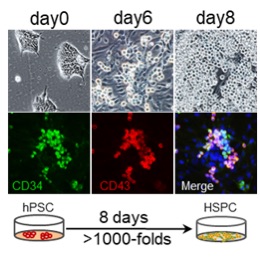Dr. Jie Na’s group reports a new method to efficiently produce hematopoietic st...
Dr Jie Na’s research group published a paper titled “Biphasic modulation of insulin signaling enables highly efficient hematopoietic differentiation from human pluripotent stem cells” in Stem Cell Research and Therapy on July 27th, 2018. Researchers discovered the biphasic role of insulin-mTOR signaling during hematopoietic stem/progenitor cell (HSPC) formation from human pluripotent stem cells. This finding may help to formulate cost effective method to make different types of blood cells and immune cells for regenerative medicine.

Hematopoietic lineage cells derived from human pluripotent stem cells (hPSCs) can be used to study human blood system development, to model hematological diseases and to provide sufficient cells for immune therapy. In this study, researchers established a simple, chemically defined and cost effective platform to produce HSPCs from hPSCs efficiently in 8 days. One hPSC can generate more than 1000 HPSCs after 8 days of differentiation. Researchers showed that the key to achieve such high efficiency is to first inhibit, then activate the insulin/mTOR signaling pathway. Insulin-free condition markedly accelerated vascular mesoderm induction from hPSCs, while insulin-mTOR signaling was required for hemogenic endothelium development and the formation of HSPCs. Pluripotent stem cells derived HSPCs can be induced to form macrophages by cytokines. These laboratory-produced macrophages exhibited robust phagocytic ability towards human pathogen bacterium and could be infected by ZIKA virus. Therefore, potentially, they can be used to study the interaction between human macrophages and human specific pathogens.
Dr. Jie Na from the School of Medicine, Tsinghua University, is the corresponding author of this work. Ph.D. candidate, Mr. Fuyu Duan is the first author. Collaborators include Dr Wei Guo from Zhejiang University, Dr Sophia Chia-Ning Chang from China Medical University, Taiwan, and Dr Xiaoyu Hu from the Institute of Immunology and School of Medicine, Tsinghua University. This work also received technical assistance and experimental pathogens provided by Drs Babak Javid, Xin Lin and Linqi Zhang at Tsinghua University. This work was supported by funding from the National Key R&D Program of China, the National Natural Science Foundation of China, Tsinghua University Initiative Scientific Research Program and Tsinghua–Peking Center for Life Sciences.
◎ The paper link:
https://stemcellres.biomedcentral.com/articles/10.1186/s13287-018-0934-x